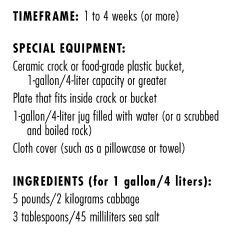Wild Fermentation
Fermented food cookbook
Yogurt, bread, beer, kimchi, wine, cheese, miso, kraut, and vinegar are among the many foods produced with the aid of microorganisms. Those are living beasties of a type that we ordinarily try to remove from what we eat. This cookbook $21 is full of fermentation recipes. It presents a unified theory of “live-culture foods,” a way of connecting their different methods in order to understand why fermentation is a Good Thing, and why there should be more of it.
Fermentation is fairly easy to do. It can self-correct many beginner’s errors. It is definitely a slow-food process, but at the same time, a low-effort process since the bugs do most of the work. The recipes here are starter ones, broad in scope, easy to do, just to get you going. The appendix contains a good roundup of sources for a large variety of live cultures. You can find deeper more complex recipes in specific books, but here in one slim volume is a great introduction to how to ferment. At least once, you should make your own yogurt, bread, beer, kimchi, wine, cheese, miso, kraut, and vinegar. Find what you do well and make more of it.
More importantly, ferment something new.
05/14/19Excerpt
By eating a variety of live fermented foods, you promote diversity among microbial cultures in your body.
*

*
I know of no food that is without some tradition of fermentation.
*
Hamid Dirar has identified eighty distinct fermentation processes in The Indigenous Fermented Food of the Sudan, a book describing an incredible array of ferments that result in consumption of every bit of animal flesh and bone.
(This is a Cool Tools Favorite from 2011 — editors)
Wild Fermentation Sandor Ellix Katz 2003, 200 pages $21






